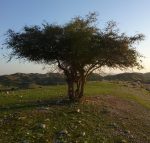 Christ’s thorn jujube is a shrub or small tree native to Africa, the Levant, and southern and western Asia where it grows in a variety of habitats including deserts, semi-desert washes, valley, and savannas as well as along the edges of ponds and riverbanks. A member of the buckthorn family, Rhamnacea, it is evergreen where the water supply is adequate, but deciduous in dry areas or during the dry season. Growing from a deep taproot and spreading lateral roots, the plants can grow up to 50′ tall but are usually considerably shorter, and have spreading grayish white branches that start low and rise to create a thick tangled canopy. The ovate-elliptic or suborbicular leaves are .4-2.4″ long and usually have 2 stipular spines at their base, on erect and .8″ long the other recured and .2-.3″ long. The axillary, greenish yellow flowers are slightly fragrant, less than .2″ across, and appear in the fall. The fruit is a red-yellow to yellow green round one seeded drupe .5-1″ across with an edible pulp. Photo Credit: Meincluded, Wikipedia
Christ’s thorn jujube is a shrub or small tree native to Africa, the Levant, and southern and western Asia where it grows in a variety of habitats including deserts, semi-desert washes, valley, and savannas as well as along the edges of ponds and riverbanks. A member of the buckthorn family, Rhamnacea, it is evergreen where the water supply is adequate, but deciduous in dry areas or during the dry season. Growing from a deep taproot and spreading lateral roots, the plants can grow up to 50′ tall but are usually considerably shorter, and have spreading grayish white branches that start low and rise to create a thick tangled canopy. The ovate-elliptic or suborbicular leaves are .4-2.4″ long and usually have 2 stipular spines at their base, on erect and .8″ long the other recured and .2-.3″ long. The axillary, greenish yellow flowers are slightly fragrant, less than .2″ across, and appear in the fall. The fruit is a red-yellow to yellow green round one seeded drupe .5-1″ across with an edible pulp. Photo Credit: Meincluded, Wikipedia
There are many spiny plants mentioned in the Bible and much uncertainty regarding the identity of these throny plants exists. Z. spina christi is only one of many possible plants that may be translated as thorn/thornbush. The fruit and leaves of Christ’s thorn jujube have been used since ancient Egyptian times for medicine and food and the plant is very common in the Jordan Valley and around Jerusalem. The oldest Z. spina-christi tree is near Jerusalem and is estimated to be between 1500 and 2000 years old. Local tradition says that this tree is the actual one from which Jesus’ crown of thorns was made but some experts believe the tree is too tall to harvest branches easily and the branches are too brittle to be bent into a crown and suggest Ziziphus lotus or Paliurus spina-christi as possible alternatives.
Judges 8:7 (NIV) Gideon addresses the men of Succoth.
“Then Gideon replied, “Just for that, when the LORD has given Zebah and Zalmunna into my hand, I will tear your flesh with desert thorns and briers.”
Isaiah 7.19 (NIV) Judah is warned of the attacked by both Assyria and the Egyptians.
“They will all come and settle in the steep ravines and in the crevices in the rocks, on all the thornbushes and at all the water holes.”
Isaiah 55:13 (NIV) The prophet describes the joys and blessings of turning to God.
“Instead of the thornbush will grow the juniper, and instead of briers the myrtle will grow. This will be for the LORD’s renown, for an everlasting sign, that will endure forever.”
Mathew 7:16 (NIV) Jesus warns against false prophets.
“By their fruit you will recognize them. Do people pick grapes from thornbushes, or figs from thistles?”
Christ’s thorn jujube likes full sun and average, medium moist, alkaline soil in USDA Hardiness Zones 10-13 but tolerates drought, heat and saline conditions. Propagation is by seed. Plants have no significant pests or diseases. They are used from the wild for food, medicine, and materials, and are cultivated for their fruit, as a hedge and as a source of shade.
The genus name, Ziziphus, is derived from the Persian name zizfum. The specific epithet, spina-christi, is the Latin phrase meaning thorns of Christ because it is believed to be the plant from which Christ’s crucifixion crown was made.